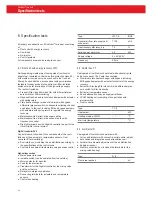
100
3.5 Heat output
Note
The performance data listed here applies to the most frequent design conditions. Use the
selection program 'HK-Select' to calculate the performance data for other design data.
You can download 'HK-Select' free of charge on the Internet.
Fresh air temperature
-5 °C
-15 °C
LPHW
Size
Type
Q
Q
TG
H
max
t
S
∆p
W
m
W
Q
Q
TG
H
max
t
S
∆p
W
m
W
°C
kW
kW
m
°C
kPa
l/h
kW
kW
m
°C
kPa
l/h
80/60
TWC-9
C
98
90
8.3
54
8 4195
100
89
8.3
54
8 4299
D
–
–
–
–
–
–
–
–
–
–
–
–
60/40
TWC-9
C
58
50
10.8
38
3 2508
61
50
10.9
38
3 2613
D
71
63
9.8
43
3 3038
74
62
9.8
43
4 3162
Legend:
Type =
Type of heating coil
Q
=
Heat output
Q
TG
=
Output to cover fabric heat losses
H
max
=
Maximum mounting height
t
S
=
Supply air temperature
∆p
W
=
Water pressure drop
m
W
=
Water flow rate
Refers to:
Room air 18 °C, extract air 20 °C / 40 % rel. humidity
— These operating conditions are not permissible, because the maximum supply air temperature of 60 °C is exceeded.
Table E6: Heat output of the RoofVent
®
twin cool
Note
The output for coverage of fabric heat losses (Q
TG
) allows for the ventilation heat requirement
(Q
V
) and the output of the energy recovery (Q
ER
) under the respective air conditions. It is calcu-
lated as follows: Q
TG
= Q + Q
ER
– Q
V
RoofVent
®
twin cool
Technical data
Summary of Contents for RoofVent CON-9
Page 2: ......
Page 4: ...2...
Page 6: ...4...
Page 8: ...6...
Page 12: ...10 RoofVent LHW Use...
Page 40: ...38 RoofVent LKW Use...
Page 68: ...66 RoofVent twin heat Use...
Page 94: ...92 RoofVent twin cool Use...
Page 122: ...120 RoofVent twin pump Use...
Page 150: ...148...
Page 154: ...152 RoofVent condens Use...
Page 180: ...210 RoofVent LH Construction and operation...
Page 208: ...238 RoofVent LK Use...
Page 256: ...286...
Page 268: ...298...
Page 274: ...304...
Page 279: ......








































